
The Unseen Predator: Why Yellowstone’s Wildness Continues to Claim the Unwary
It begins with a click. A smartphone raised, a grin stretched wide, a majestic beast in the background. The bison, seemingly docile, grazing just yards away, becomes a prop in a tourist’s digital quest for the perfect memory. But in Yellowstone National Park, America’s first and arguably most iconic national park, the pursuit of that perfect photo often comes with a perilous price. The "Yellowstone tragedy" isn’t a single event, but a recurring, preventable saga of human hubris meeting untamed nature, where the park’s most emblematic animal, the bison, frequently becomes the reluctant instrument of harsh lessons.
Each year, as millions flock to witness Yellowstone’s geothermal wonders and abundant wildlife, a predictable pattern emerges: reports of visitors gored, trampled, and sometimes killed, by the very creatures they sought to admire. Despite omnipresent warnings, educational campaigns, and the sheer common sense that dictates respect for wild animals, the incidents persist, raising questions about human perception, the allure of the selfie, and the inherent, often brutal, reality of a truly wild landscape.
The Majesty and the Menace

The American bison, a symbol of the Old West and a conservation success story, is a creature of immense power and unpredictable temperament. Weighing up to 2,000 pounds and capable of charging at speeds of 35 miles per hour, these shaggy giants are not the domesticated cattle many tourists mistake them for. They are wild animals, and Yellowstone is their home, not a petting zoo.
"People forget these animals are wild," says a long-time Yellowstone park ranger, who wishes to remain anonymous due to park policy. "They see them grazing peacefully, and they think they’re gentle giants. But a bison’s ‘personal space’ is much larger than a human’s, and they can go from calm to full-on charge in a split second if they feel threatened, especially during calving season or the rut."
Park regulations explicitly state that visitors must stay at least 25 yards (23 meters) away from bison and elk, and 100 yards (91 meters) from bears and wolves. These aren’t arbitrary suggestions; they are safety mandates born from decades of observation and, tragically, from painful experience. Yet, a quick glance at social media or a stroll through any popular Yellowstone viewpoint reveals countless instances of these rules being flagrantly disregarded.
The Selfie Syndrome and the Illusion of Control
In an age dominated by social media, the desire for a unique, shareable experience has reached fever pitch. For many, a trip to Yellowstone isn’t complete without a close-up encounter, captured on camera, that screams "I was there!" This "selfie syndrome" often overrides basic self-preservation instincts. Tourists creep closer, sometimes turning their backs on the animal, their focus solely on framing the shot, oblivious to the warning signs: a flick of the tail, a head shake, a pawing of the ground.
One particularly harrowing incident occurred in 2022 when a 25-year-old woman approached a bison near the Old Faithful boardwalk. Despite repeated warnings from other visitors, she got within ten feet of the animal. The bison charged, goring her and tossing her ten feet into the air. Miraculously, she survived with serious injuries, but the incident served as a stark, public reminder of the consequences.
Such events are not isolated. In 2015, three separate bison gorings occurred within a span of weeks, including an incident where a 62-year-old Australian man was gored while posing for photos, and a 16-year-old Taiwanese exchange student was tossed into the air after turning her back on a bison to take a picture. The common denominator? A blatant disregard for established safety distances.
"It’s a bizarre disconnect," observes Dr. Eleanor Vance, a sociologist specializing in human-wildlife interactions. "People consume so much filtered, curated content online that they start to view reality through that lens. A wild animal becomes a prop, not a living, breathing, unpredictable force of nature. They see a bison on a screen, and it looks safe. They forget there’s no screen between them and the animal in real life."

The Park’s Herculean Task
Yellowstone National Park spans over 2.2 million acres and welcomes more than four million visitors annually. Managing human-wildlife interactions on such a scale is a monumental challenge. The National Park Service (NPS) employs a multi-pronged approach to visitor education:
- Signage: Prominently displayed at trailheads, boardwalks, and visitor centers, featuring clear graphics and warnings.
- Brochures and Maps: Distributed at entrances, reiterating safety guidelines.
- Digital Warnings: Via the park’s website, social media, and even push notifications for those using the park’s app.
- Ranger Presence: Park rangers actively patrol popular areas, offering verbal warnings and advice.
- Educational Programs: Junior Ranger programs and evening talks often emphasize wildlife safety.
Despite these exhaustive efforts, the message doesn’t always penetrate. "We literally have signs that say, ‘Bison are dangerous. Stay 25 yards away.’ We say it in every language we can think of," exasperatedly states a Yellowstone spokesperson during a press briefing following a recent incident. "We can’t put a ranger next to every single bison, and we certainly can’t babysit every visitor. At some point, personal responsibility has to come into play."
The tragedy isn’t just the physical harm; it’s the resource drain. Every goring incident triggers a complex emergency response involving rangers, medical personnel, and often helicopter evacuations. These resources are diverted from other critical park operations, impacting conservation efforts and general park management.
The Deeper Lesson: Respect for the Wild
The Yellowstone tragedy is more than just a series of unfortunate encounters; it’s a stark metaphor for humanity’s often-strained relationship with the natural world. In our increasingly urbanized, controlled environments, many have lost touch with the raw, untamed essence of nature. Yellowstone, with its geysers erupting on schedule and its animals seemingly posing for photos, can give the illusion of a managed theme park. But it is not. It is a vibrant, dynamic ecosystem where primal instincts still rule.
The bison, in its unyielding wildness, serves as a powerful reminder of this truth. It does not exist for human entertainment or photographic opportunities. It exists as it has for millennia, an integral part of an ancient landscape. Its charge, while terrifying for the victim, is merely a defense mechanism, a declaration of boundaries that humans, in their technological bubble, have forgotten how to read or respect.
"We come to places like Yellowstone seeking authenticity, a connection to something ancient and powerful," reflects Dr. Vance. "But then we try to impose our own rules on it, to domesticate it for our cameras. The bison’s charge is nature’s blunt way of saying, ‘You are not in charge here.’"
Moving Forward: A Call for Awareness
Preventing future Yellowstone tragedies doesn’t require new regulations or more rangers, but a fundamental shift in visitor mindset. It requires a conscious decision to prioritize safety and respect over a fleeting social media moment.
The solution is remarkably simple:
- Maintain Distance: Adhere strictly to the 25-yard rule for bison and elk, and 100 yards for bears and wolves. Use zoom lenses for photos, not your feet.
- Observe and Learn: Pay attention to animal behavior. If an animal seems agitated or changes its behavior because of your presence, you are too close.
- Educate Yourself: Read park materials, watch safety videos, and listen to ranger advice.
- Remember Where You Are: Yellowstone is a wild place. Its beauty lies in its untamed nature. Embrace it, respect it, and allow its wild inhabitants the space they need to thrive, undisturbed.
The Yellowstone tragedy will continue as long as human ignorance and arrogance clash with the park’s wild heart. It’s a preventable tragedy, one that calls upon each visitor to shed the illusion of control and embrace the profound humility that comes with truly experiencing one of the last great wild places on Earth. The bison is not the villain; it is merely wild. The choice to respect that wildness, or to suffer the consequences, lies squarely with us.


